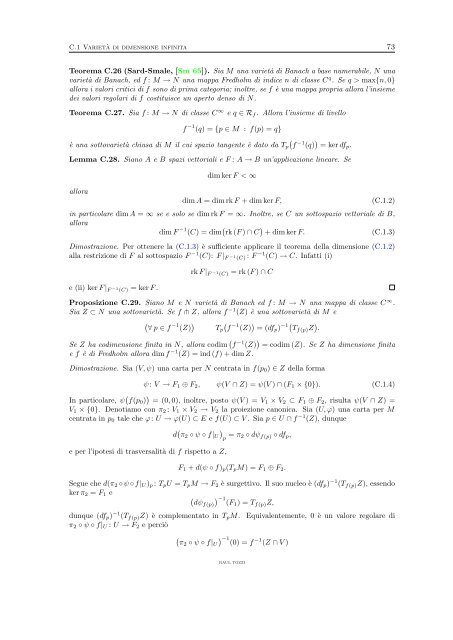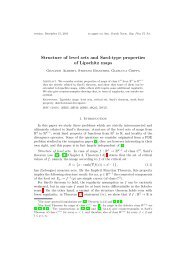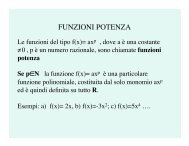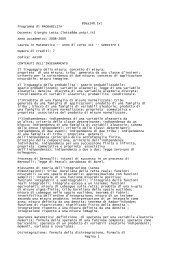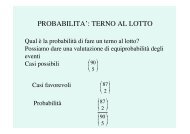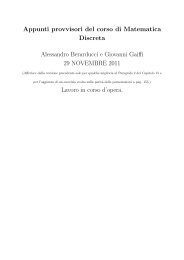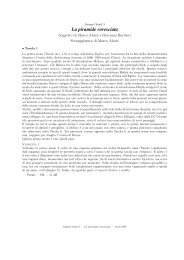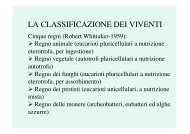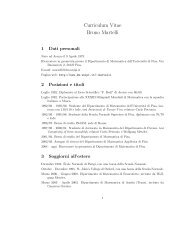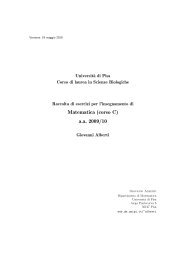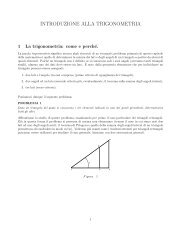Immersioni aperte in dimensione infinita - Dipartimento di Matematica
Immersioni aperte in dimensione infinita - Dipartimento di Matematica
Immersioni aperte in dimensione infinita - Dipartimento di Matematica
You also want an ePaper? Increase the reach of your titles
YUMPU automatically turns print PDFs into web optimized ePapers that Google loves.
C.1 Varietà <strong>di</strong> <strong><strong>di</strong>mensione</strong> <strong>in</strong>f<strong>in</strong>ita 73<br />
Teorema C.26 (Sard-Smale, [Sm 65]). Sia M una varietà <strong>di</strong> Banach a base numerabile, N una<br />
varietà <strong>di</strong> Banach, ed f : M → N una mappa Fredholm <strong>di</strong> <strong>in</strong><strong>di</strong>ce n <strong>di</strong> classe C q . Se q > max{n, 0}<br />
allora i valori critici <strong>di</strong> f sono <strong>di</strong> prima categoria; <strong>in</strong>oltre, se f è una mappa propria allora l’<strong>in</strong>sieme<br />
dei valori regolari <strong>di</strong> f costituisce un aperto denso <strong>di</strong> N.<br />
Teorema C.27. Sia f : M → N <strong>di</strong> classe C ∞ e q ∈ Rf . Allora l’<strong>in</strong>sieme <strong>di</strong> livello<br />
f −1 (q) = {p ∈ M : f(p) = q}<br />
<br />
−1 è una sottovarietà chiusa <strong>di</strong> M il cui spazio tangente è dato da Tp f (q) = ker dfp.<br />
Lemma C.28. Siano A e B spazi vettoriali e F : A → B un’applicazione l<strong>in</strong>eare. Se<br />
allora<br />
<strong>di</strong>m ker F < ∞<br />
<strong>di</strong>m A = <strong>di</strong>m rk F + <strong>di</strong>m ker F, (C.1.2)<br />
<strong>in</strong> particolare <strong>di</strong>m A = ∞ se e solo se <strong>di</strong>m rk F = ∞. Inoltre, se C un sottospazio vettoriale <strong>di</strong> B,<br />
allora<br />
<strong>di</strong>m F −1 (C) = <strong>di</strong>m rk (F ) ∩ C + <strong>di</strong>m ker F. (C.1.3)<br />
Dimostrazione. Per ottenere la (C.1.3) è sufficiente applicare il teorema della <strong><strong>di</strong>mensione</strong> (C.1.2)<br />
alla restrizione <strong>di</strong> F al sottospazio F −1 (C): F | F −1 (C) : F −1 (C) → C. Infatti (i)<br />
e (ii) ker F | F −1 (C) = ker F .<br />
rk F | F −1 (C) = rk (F ) ∩ C<br />
Proposizione C.29. Siano M e N varietà <strong>di</strong> Banach ed f : M → N una mappa <strong>di</strong> classe C∞ .<br />
Sia Z ⊂ N una sottovarietà. Se f ⋔ Z, allora f −1 (Z) è una sottovarietà <strong>di</strong> M e<br />
−1 −1<br />
∀ p ∈ f (Z) f (Z) = (dfp) −1 Tf(p)Z .<br />
Tp<br />
Se Z ha co<strong><strong>di</strong>mensione</strong> f<strong>in</strong>ita <strong>in</strong> N, allora co<strong>di</strong>m f −1 (Z) = co<strong>di</strong>m (Z). Se Z ha <strong><strong>di</strong>mensione</strong> f<strong>in</strong>ita<br />
e f è <strong>di</strong> Fredholm allora <strong>di</strong>m f −1 (Z) = <strong>in</strong>d (f) + <strong>di</strong>m Z.<br />
Dimostrazione. Sia (V, ψ) una carta per N centrata <strong>in</strong> f(p0) ∈ Z della forma<br />
ψ : V → F1 ⊕ F2, ψ(V ∩ Z) = ψ(V ) ∩ (F1 × {0}). (C.1.4)<br />
In particolare, ψ f(p0) = (0, 0), <strong>in</strong>oltre, posto ψ(V ) = V1 × V2 ⊂ F1 ⊕ F2, risulta ψ(V ∩ Z) =<br />
V1 × {0}. Denotiamo con π2 : V1 × V2 → V2 la proiezione canonica. Sia (U, ϕ) una carta per M<br />
centrata <strong>in</strong> p0 tale che ϕ: U → ϕ(U) ⊂ E e f(U) ⊂ V . Sia p ∈ U ∩ f −1 (Z), dunque<br />
d <br />
π2 ◦ ψ ◦ f|U<br />
e per l’ipotesi <strong>di</strong> trasversalità <strong>di</strong> f rispetto a Z,<br />
p = π2 ◦ dψ f(p) ◦ dfp,<br />
F1 + d(ψ ◦ f)p(TpM) = F1 ⊕ F2.<br />
Segue che d(π2 ◦ ψ ◦ f|U )p : TpU = TpM → F2 è surgettivo. Il suo nucleo è (dfp) −1 (Tf(p)Z), essendo<br />
ker π2 = F1 e<br />
−1(F1) dψf(p) = Tf(p)Z, dunque (dfp) −1 (T f(p)Z) è complementato <strong>in</strong> TpM. Equivalentemente, 0 è un valore regolare <strong>di</strong><br />
π2 ◦ ψ ◦ f|U : U → F2 e perciò<br />
−1(0) −1<br />
π2 ◦ ψ ◦ f|U = f (Z ∩ V )<br />
RAUL TOZZI


